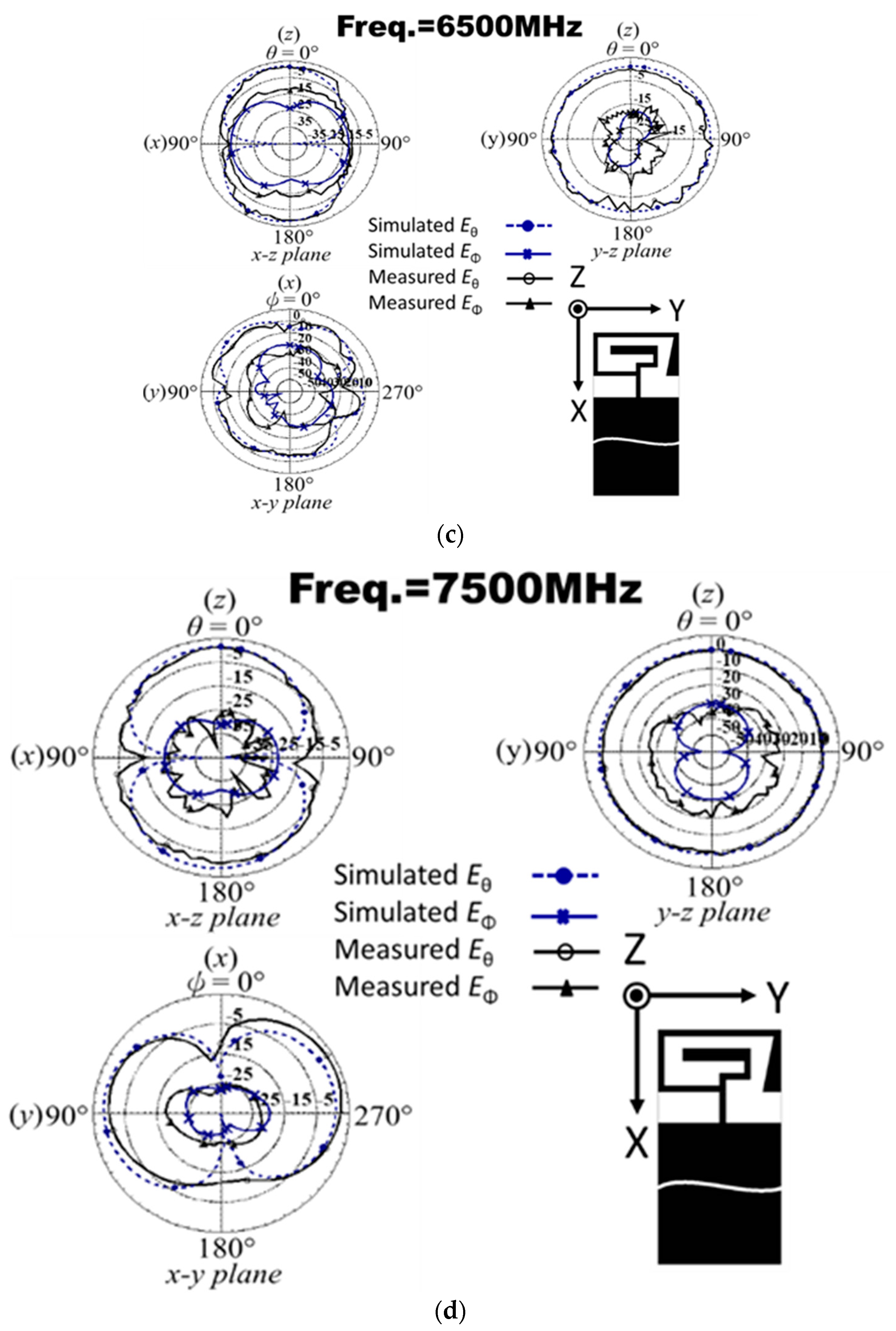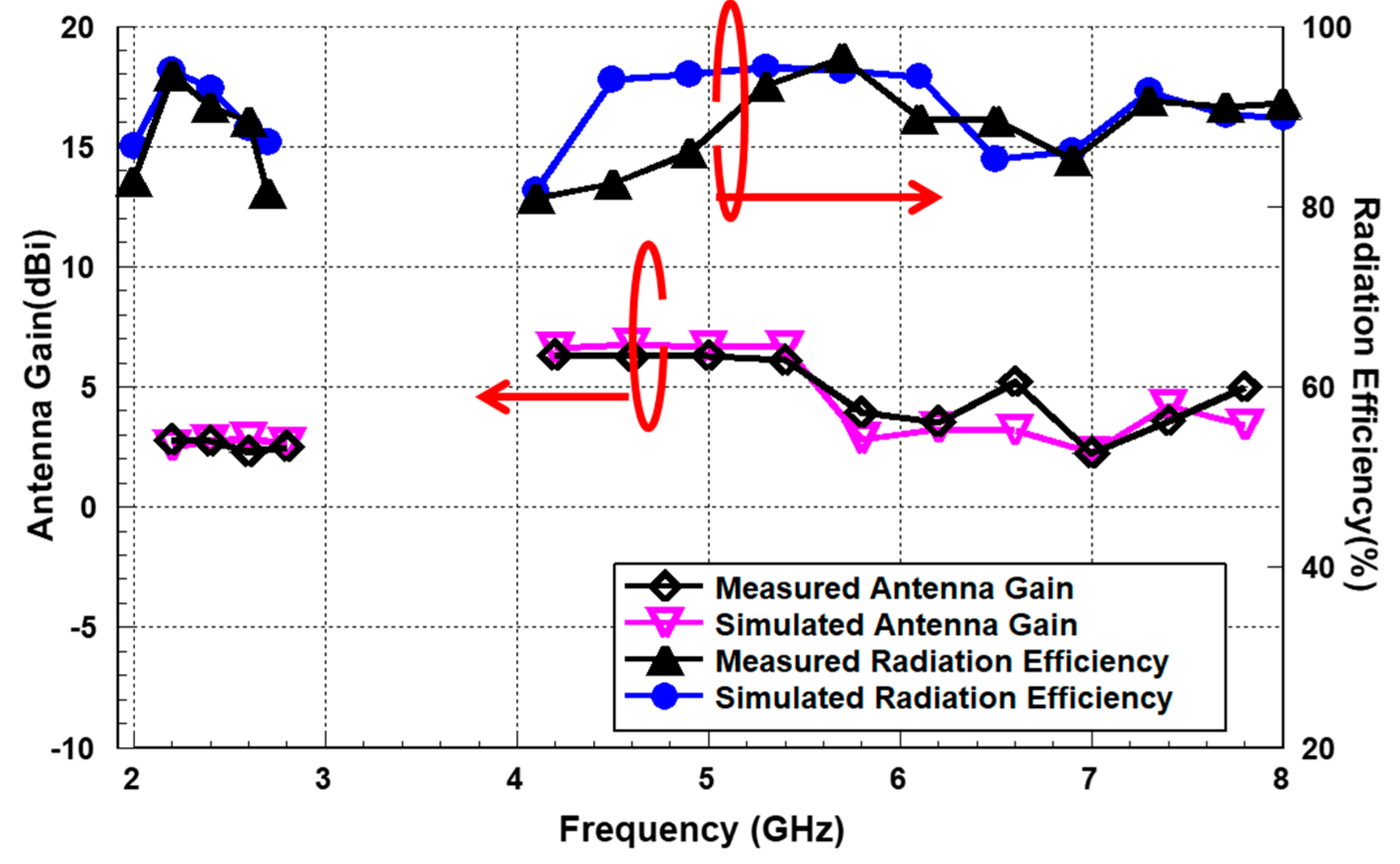Miniaturized Broadband-Multiband Planar Monopole Antenna in Autonomous Vehicles Communication System Device
Abstract
:1. Introduction
2. Recommended Monopole Antenna Construction
3. Validation Analysis, Results, and Discussion
4. Conclusions
Author Contributions
Funding
Data Availability Statement
Conflicts of Interest
References
- Bassoli, R.; Granelli, F.; Arzo, S.T.; Di Renzo, M. Toward 5G cloud radio access network: An energy and latency perspective. Trans. Emerg. Telecommun. Technol. 2021, 32, e3669. [Google Scholar] [CrossRef]
- Zebari, G.M.; Zebari, D.A.; Al-zebari, A. Fundamentals of 5G Cellular Networks: A Review. J. Inf. Technol. Inform. 2021, 1, 1–5. [Google Scholar]
- Kao, L.-C.; Liao, W. 5G intelligent A+: A pioneer multi-access edge computing solution for 5G private networks. IEEE Commun. Stand. Mag. 2021, 5, 78–84. [Google Scholar] [CrossRef]
- Gao, G.; Li, W. Architecture of visual design creation system based on 5G virtual reality. Int. J. Commun. Syst. 2021, e4750. [Google Scholar]
- Alshouiliy, K.; Agrawal, D.P. Confluence of 4g lte, 5g, fog, and cloud computing and understanding security issues. In Fog/Edge Computing For Security, Privacy, and Applications; Springer: Cham, Switzerland, 2021; pp. 3–32. [Google Scholar]
- Chan, T.K.; Chin, C.S. Review of autonomous intelligent vehicles for urban driving and parking. Electronics 2021, 10, 1021. [Google Scholar] [CrossRef]
- Mahmoud, H.H.H.; Amer, A.A.; Ismail, T. 6G: A comprehensive survey on technologies, applications, challenges, and research problems. Trans. Emerg. Telecommun. Technol. 2021, 32, e4233. [Google Scholar]
- Dao, N.-N.; Pham, Q.-V.; Tu, N.H.; Thanh, T.T.; Bao, V.N.Q.; Lakew, D.S.; Cho, S. Survey on aerial radio access networks: Toward a comprehensive 6g access infrastructure. IEEE Commun. Surv. Tutor. 2021, 23, 1193–1225. [Google Scholar] [CrossRef]
- Guo, F.; Yu, F.R.; Zhang, H.; Li, X.; Ji, H.; Leung, V.C. Enabling massive IoT toward 6G: A comprehensive survey. IEEE Internet Things J. 2021, 8, 11891–11915. [Google Scholar] [CrossRef]
- Kulkarni, J. Wideband cpw-fed oval-shaped monopole antenna for wi-fi5 and wi-fi6 applications. Prog. Electromagn. Res. C 2021, 107, 173–182. [Google Scholar] [CrossRef]
- Kulkarni, J.; Sim, C.Y.D. Multiband, miniaturized, maze shaped antenna with an air-gap for wireless applications. Int. J. RF Microw. Comput.-Aided Eng. 2021, 31, e22502. [Google Scholar] [CrossRef]
- Xu, H.; Chen, Z.; Zhao, Z.; Liu, H.; Zhu, S. A flexible and compact tri-band antenna for vehicular wireless video transmission systems. Int. J. RF Microw. Comput.-Aided Eng. 2021, 31, e22741. [Google Scholar] [CrossRef]
- Wong, K.-L.; Chang, H.-J.; Wang, C.-Y.; Wang, S.-Y. Very-low-profile grounded coplanar waveguide-fed dual-band WLAN slot antenna for on-body antenna application. IEEE Antennas Wirel. Propag. Lett. 2019, 19, 213–217. [Google Scholar] [CrossRef]
- Wen, L.; Gao, S.; Yang, Q.; Luo, Q.; Yin, Y.; Ren, X.; Wu, J. A compact monopole antenna with filtering response for WLAN applications. In Proceedings of the 2019 International Symposium on Antennas and Propagation (ISAP), Xi’an, China, 27–30 October 2019; pp. 1–3. [Google Scholar]
- Liu, D.Q.; Zhang, M.; Luo, H.J.; Wen, H.L.; Wang, J. Dual-band platform-free PIFA for 5G MIMO application of mobile devices. IEEE Trans. Antennas Propag. 2018, 66, 6328–6333. [Google Scholar] [CrossRef]
- Ali, T.; Khaleeq, M.M.; Biradar, R.C. A multi-band reconfigurable slot antenna for wireless applications. AEU-Int. J. Electron. Commun. 2018, 84, 273–280. [Google Scholar] [CrossRef]
- Rezapour, M.; Rashed-Mohassel, J.; Keshtkar, A.; Naser-Moghadasi, M. Isolation enhancement of rectangular dielectric resonator antennas using wideband double slit complementary split ring resonators. Int. J. RF Microw. Comput.-Aided Eng. 2019, 29, e21746. [Google Scholar] [CrossRef]
- Ng, W.-H.; Lim, E.-H.; Bong, F.-L.; Chung, B.-K. Folded patch antenna with tunable inductive slots and stubs for UHF tag design. IEEE Trans. Antennas Propag. 2018, 66, 2799–2806. [Google Scholar] [CrossRef]
- Kulkarni, J. Multi-band printed monopole antenna conforming bandwidth requirement of GSM/WLAN/WiMAX standards. Prog. Electromagn. Res. Lett. 2020, 91, 59–66. [Google Scholar] [CrossRef]
- Ghaffar, A.; Li, X.J.; Hussain, N.; Awan, W.A. Flexible frequency and radiation pattern reconfigurable antenna for multi-band applications. In Proceedings of the 2020 4th Australian Microwave Symposium (AMS), Sydney, NSW, Australia, 13–14 February 2020; pp. 1–2. [Google Scholar]
- Yang, G.; Zhang, S.; Li, J.; Zhang, Y.; Pedersen, G.F. A multi-band magneto-electric dipole antenna with wide beam-width. IEEE Access 2020, 8, 68820–68827. [Google Scholar] [CrossRef]
- Chung, M.A. Embedded 3D multi-band antenna with ETS process technology covering LTE/WCDMA/ISM band operations in a smart wrist wearable wireless mobile communication device design. IET Microw. Antennas Propag. 2020, 14, 93–100. [Google Scholar] [CrossRef]
- Camacho-Gomez, C.; Sanchez-Montero, R.; Martinez-Villanueva, D.; Lopez-Espi, P.-L.; Salcedo-Sanz, S. Design of a multi-band microstrip textile patch antenna for LTE and 5G services with the CRO-SL ensemble. Appl. Sci. 2020, 10, 1168. [Google Scholar] [CrossRef] [Green Version]
- Kumar, C.M.; Muvvala, N.K. Multi band metamaterial inspired L type slot patch antenna. In Proceedings of the 2020 International Conference on Smart Technologies in Computing, Electrical and Electronics (ICSTCEE), Bengaluru, India, 9–10 October 2020; pp. 34–38. [Google Scholar]
- Khan, M.I.; Chandra, A.; Kumar, V.; Das, S. A planar dual band dual polarized slot antenna using coplanar waveguide. In Proceedings of the 2018 IEEE International Students’ Conference on Electrical, Electronics and Computer Science (SCEECS), Bhopal, India, 24–25 February 2018; pp. 1–4. [Google Scholar]
- Ghouz, H.H.M.; Sree, M.F.A.; Ibrahim, M.A. Novel wideband microstrip monopole antenna designs for WiFi/LTE/WiMax devices. IEEE Access 2020, 8, 9532–9539. [Google Scholar] [CrossRef]
- Le, T.T.; Yun, T.-Y. Miniaturization of a dual-band wearable antenna for WBAN applications. IEEE Antennas Wirel. Propag. Lett. 2020, 19, 1452–1456. [Google Scholar] [CrossRef]
- Zhang, H.; Chen, D.; Zhao, C. A novel printed monopole antenna with folded stepped impedance resonator loading. IEEE Access 2020, 8, 146831–146837. [Google Scholar] [CrossRef]
- Sreelakshmi, K.; Rao, G.S.; Kumar, M. A compact grounded asymmetric coplanar strip-fed flexible multi-band reconfigurable antenna for wireless applications. IEEE Access 2020, 8, 194497–194507. [Google Scholar] [CrossRef]
- Kulkarni, J. Multiband triple folding monopole antenna for wireless applications in the laptop computers. Int. J. Commun. Syst. 2021, 34, e4776. [Google Scholar] [CrossRef]









| References | Publication Year | Overall Size (mm2) | System Ground Size (mm2) | Antenna Size (mm2) | Operation Range (GHz) | Resonant Frequency (GHz) | Bandwidth (%) | Gain (dBi) | Applications |
|---|---|---|---|---|---|---|---|---|---|
| [26] | 2020 | 36 × 38 | 36 × 21.7 | 38 × 24.4 | 4.5–5.57 | 5.035 | 30% | 6 | WiFi/LTE/WiMax |
| (1070 MHz) | |||||||||
| [27] | 2020 | 20 × 19 | 10 × 19 | 13.5 × 10 | 2.4–2.54 | 2.74 | 5.1% (140 MHz) 3.7% (220 MHz) | 2.1 | WBAN |
| 5.72–5.94 | 5.83 | 3.5 | |||||||
| [28] | 2020 | 54 × 37 | 5 × 54 | 54 × 32 | 1.6–2.2 | 1.9 | 31.5% (600 MHz) | 1.67 | - |
| [29] | 2020 | 24 × 19 | 8 × 8.5 | 16 × 16 | 2.33–2.47 | 2.4 | 5.8% (140 MHz) 13.3% (240 MHz) 6.6% (370 MHz) | 2.26 | Bluetooth/5G NR/WLAN |
| 3.68–3.92 | 6.3 | 3.14 | |||||||
| 5.38–5.75 | 5.565 | 3.73 | |||||||
| [30] | 2021 | 260 × 208 | 260 × 200 | 21 × 8 | 2.25–2.64 | 2.445 | 5.8% (390 MHz) 13.3% (380 MHz) 6.6% (1410 MHz) | 4.38 | LTE/WIFI/sub-6 GHz/5G bands |
| 3.25–3.63 | 3.44 | 4 | |||||||
| 5–6.41 | 5.705 | 5.68 | |||||||
| Proposed | - | 50 × 10 | 42.5 × 10 | 12.5 × 7.5 | 2–2.74 | 2.46 | 31.22% (740 MHz) 65.29% (3938 MHz) | 2.7 | 5G, B5G, 4G, V2X, ISM band of WLAN, Bluetooth, WiFi 6 band and WiMAX, Sirius/XM Radio |
| 4.062–8 | 6.205 | 6.75 |
Publisher’s Note: MDPI stays neutral with regard to jurisdictional claims in published maps and institutional affiliations. |
© 2021 by the authors. Licensee MDPI, Basel, Switzerland. This article is an open access article distributed under the terms and conditions of the Creative Commons Attribution (CC BY) license (https://creativecommons.org/licenses/by/4.0/).
Share and Cite
Chung, M.-A.; Yang, C.-W. Miniaturized Broadband-Multiband Planar Monopole Antenna in Autonomous Vehicles Communication System Device. Electronics 2021, 10, 2715. https://doi.org/10.3390/electronics10212715
Chung M-A, Yang C-W. Miniaturized Broadband-Multiband Planar Monopole Antenna in Autonomous Vehicles Communication System Device. Electronics. 2021; 10(21):2715. https://doi.org/10.3390/electronics10212715
Chicago/Turabian StyleChung, Ming-An, and Chih-Wei Yang. 2021. "Miniaturized Broadband-Multiband Planar Monopole Antenna in Autonomous Vehicles Communication System Device" Electronics 10, no. 21: 2715. https://doi.org/10.3390/electronics10212715
APA StyleChung, M.-A., & Yang, C.-W. (2021). Miniaturized Broadband-Multiband Planar Monopole Antenna in Autonomous Vehicles Communication System Device. Electronics, 10(21), 2715. https://doi.org/10.3390/electronics10212715






